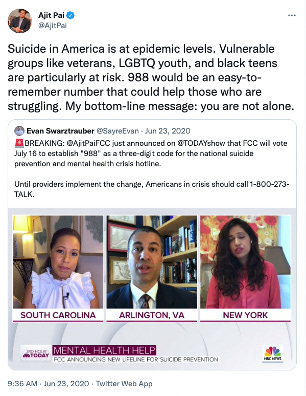In the summer of 2020 Republican FCC Chairman Ajit Pai pushed through an agency vote to establish 988 as a three-digit code for a national suicide prevention and mental health crisis hotline. This followed years of bipartisan efforts and a law signed by President Donald Trump to reinvigorate this life saving hotline. As of Saturday, the new national suicide hotline 988 finally went live.
The three digit code allows anyone in the US who is experiencing a mental health emergency to call or text trained counselors who are standing by to help. The 3 digit number makes it considerably easier for those in need to utilize than trying to remember the former eleven digit 1-800 number.
As former FCC Chairman Ajit Pai recently wrote, “This will be transformational for millions of Americans. Nationwide availability of 988 will save lives by enabling more people who are struggling to connect with those who can help. It is much easier to remember 988 than an 11-digit number, which means more Americans will contact the Lifeline and get potentially life-saving counsel. And because 988 has an echo of 911—the emergency number that virtually every American knows—988 could well become a commonly understood number, just as 911 is today.”
Anyone in the middle of a mental health crisis or with a substance abuse issue should feel free to call 988. The counselors manning the calls are trained on a wide array of mental health issues. As Hannah Wesolowski, chief advocacy officer at the National Alliance on Mental Illness explains, “If someone has been through a traumatic event and is struggling to process it — and there are traumatic events happening throughout this country — this is a place to turn to.”
Additionally, an individual can call 988 on behalf of someone else experiencing a mental health hardship. This makes it easier for people to help a friend or loved one better navigate the process of getting the help they need.
This hotline will undoubtedly save lives and help alleviate the current mental health crisis that is plaguing so many communities throughout the nation. Its creation is a testament to the commitment different federal agencies and Congress have made to utilize emerging technologies to help those in need. This effort was also made possible by the hard work of non profits such as The Trevor Project, Alliance for Hope, and American Foundation for Suicide Prevention who have been leveraging different tactics and emerging technology to help those in need.




